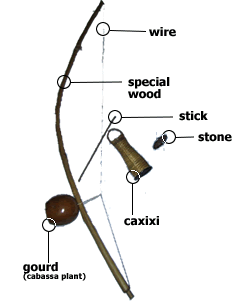 Orinally
brought to Brazil in the 1500's by Bantù slaves from
Africa and used to accompany the famous dance called Capoeira
(it's a sort of a martial art were two fighter are trained while
berimbau, tambourine and agogo bells play a rhythm).
Orinally
brought to Brazil in the 1500's by Bantù slaves from
Africa and used to accompany the famous dance called Capoeira
(it's a sort of a martial art were two fighter are trained while
berimbau, tambourine and agogo bells play a rhythm).
Berimbau was also a mean of communication used
by slaves to prevent to be understood by their bosses and is
considered a sacred instrument.
Is made by a wooden arc (a special kind of wood
called Biriba), a wire from end to end and a gourd (cabassa
plant) opened on one side (resonator) attached with a piece
of cord at the lower side of the arc (20cm from the bottom).
Moving the gourd back and forth from the abdomen
creates a kind of wah-wah effect. You also can vary the "feel"
of each sound.
To play berimbau You need a stick to strike the wire, a stone
or a coin which is held against the wire and one ore more caxixi.
Basically, there are three different sound:
Moving the gourd back and forth AND changing
the position of the coin allows you to create slides between
the different notes. The berimbau is also a great instrument
to experiment w/.
First example of berimbau pattern and key notation:
